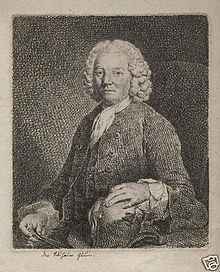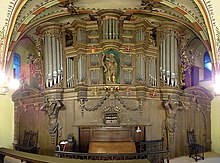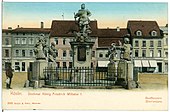Johann Georg Glume
Johann Georg Glume (born January 6, 1679 in Wanzleben , † 1765 or February 3, 1767 in Berlin ) was a German sculptor in the Baroque period .
Live and act
Johann Georg Glume was a student and then an employee of the master builder and sculptor Andreas Schlueter , the most important of the artists whom Frederick I had appointed to furnish Berlin as a royal residence at his court . However, the artist's lexicon published by Carl Heinrich von Heineken in 1768 does not reveal what part Glume played in Schlüter's work. The first work [...] with which his name can be associated is the sarcophagus of Prince Friedrich Wilhelm (1710–1711), who died in 1711, the second son of Crown Prince Friedrich Wilhelm . Glume made the model for the pewter coffin, designed in the baroque style, with skulls, winged Saturn heads, cartouches and a crown resting on a cushion.
After his accession to the throne in 1713, Friedrich Wilhelm made drastic reallocations of expenses in favor of the army. He fired numerous builders and artists or halved their salaries. One of the numerous artists who left the court was Schlueter, who went to Russia in 1713, where he died a year later. Glume was one of the few who stayed in Berlin under the given changes. In the Schlüterscher tradition he created sculptures on building facades, but made a name for himself above all in the area of sacred and sepulcral furnishings. The epitaphs , tombs and wooden organ prospectuses made of sandstone, marble and alabaster have largely been preserved in Berlin and Brandenburg city and village churches.
These include the prospectus of the St. Jakobi Church in his birthplace Wanzleben, created in 1712, or the organ prospectuses for the instruments of the organ builder Joachim Wagner in the St. Mary's Church in Berlin and in Brandenburg an der Havel in the St. Peter and Cathedral Paul and St. Catherine's Church . The only works he signed with his name are the marble grave monument of the minister Johann Andreas Kraut , on which he immortalized himself in 1725 with the majuscules JOH: GEOR: GLUME INVENTOR ET SCULPTOR (in German: Johann Georg Glume inventor and sculptor) and the console grave of Hofrat Carl Gottfried Schrader, attached to a pillar in 1726, both in Berlin's Nikolaikirche .
As early as 1716/17 he made a gable relief comprising twelve panels, which was found in 1963 when the stairs to the National Gallery were being restored . The sculptural work originally adorned the gable triangle of the Alumnate of the Joachimsthal School in Berlin, built around 1716 on Burgstrasse . The relief showed Hermes , the messenger of the gods , surrounded by allegories of the seven liberal arts , musical instruments and technical equipment in the gable corners and the inscription "Gymnasium Regium Joachimicum" in the upper area. The Pomeranian estates commissioned Glume with the monument to King Friedrich Wilhelm I in Köslin , which was unveiled on July 16, 1724, as a token of thanks for the help in rebuilding the city that burned down in 1718. The monument depicted the king as a Roman emperor and was the first statue erected for a Prussian king in Pomerania. The helmets created around 1732 for the Kronprinzenpalais converted by Philipp Gerlach are also attributed to him.
In Potsdam, Glume took part in the design of the court and garrison church around 1735 . Based on a design by the master builder Christian Friedrich Feldmann (1706–1765) inspired by the king, together with master stonemason Johann Christian Angermann († 1777) and sculptor Johann Konrad Koch, he made the baroque pulpit and the entrance to the royal crypt below, the “Royal Monument”. In 1786, Friedrich Wilhelm I's son and successor Friedrich II was also buried in the grave. The entrance was flanked by the marble figures “ Mars ” and “ Bellona ” (destroyed in 1945) based on Glume's designs . In 1736, Glume was appointed court sculptor for his work. One of the works commissioned by Friedrich Wilhelm I was the monument to the Great Elector Friedrich Wilhelm in Rathenow , which Glume completed between 1736 and 1738 based on a design by Bartolomé Damart . In memory of the victory in the Battle of Fehrbellin , the statue shows the elector in the splendid armor of a Roman emperor with four seated slave figures on the base.
From the 1740s onwards, Johann Georg Glume no longer created any works by hand. In his workshop, in which his sons Friedrich Christian and Carl Philipp already worked, however, sculptures in which he was involved continued to be made. As the main heir, his youngest son Carl Philipp probably continued his father's workshop from 1753.
family
Johann Georg Glume was married to Elisabeth Benigna, nee Schmied. The eldest son, Johann Gottlieb (1711–1778), trained as a painter and etcher . He made two etchings from his father's portrait. Two sons learned sculpture from Glume. The second oldest, Friedrich Christian, adorned the buildings and gardens of Frederick II with his works, and the youngest, Carl Philipp (1724–1776), worked as a sculptor and medalist in the Berlin workshop .
Works (selection)
Tombs and Epitaphs
- Sarcophagus for Prince Friedrich Wilhelm, 1711, Hohenzollern Crypt, Berlin Cathedral
- Grave chapel of the von Kraut family, 1723–1725, Nikolaikirche, Berlin
- Console grave for Carl Gottfried Schrader, † 1726, Nikolaikirche, Berlin
- Epitaph Gerresheim, † 1716, Nikolaikirche, Berlin
- Grave chapel of the Schindler family, around 1720, Nikolaikirche, Berlin
- Grave chapel of Johann Wolfgang Vermögen, † 1721, Nikolaikirche, Berlin
- Epitaph for Otto von Schlabrendorf , † 1721, Groß Machnow village church
- Epitaph of the Patow family, 1724, village church, Groß Jehser
- Crypt portal of the von Schlabrendorf family , 1725, St. Peter and Paul Cathedral, Brandenburg an der Havel
- Epitaph Johann Porst, † 1728, Nikolaikirche, Berlin
- Epitaph for Dorthea Luise Löscher, 1727, Paul-Gerhardt-Church , Lübben
- Epitaph for Luben von Wulffen , † 1727, Paul Gerhardt Church, Lübben
- Monument to Georg Abraham von Arnim , 1734, Steglitz village church
- Crypt portal for Otto Albrecht von Rohr , † 1736, Church of St. Peter and Paul , Wusterhausen / Dosse
- Epitaph for Christian Wilhelm von Thümen , 1742/43, (Glume workshop), Blankensee village church
- Epitaph for AF von Hacke , † 1743, (Glume workshop), Kleinmachnow village church , Kleinmachnow
- Epitaph for JC Schrader, † 1744, (Glume workshop), Kleinmachnow village church, Kleinmachnow
- Epitaph for Adam Otto von Viereck , 1763, (Glume workshop), Castle Church , book
Organ brochures and other equipment
- Organ brochure, 1712, St. Jakobi Church, Wanzleben
- Organ prospectus, draft before 1723, St. Marien Church, Berlin (finished by Paul de Ritter)
- Baptismal font, marble, 1724, St. Jakobi Church, Nauen
- Organ prospectus, around 1725, St. Peter and Paul Cathedral, Brandenburg an der Havel
- Organ prospectus, 1726, St. Katharinen Church, Brandenburg an der Havel
- Pulpit and entrance to the royal crypt ("Royal Monument"), around 1735, Court and Garrison Church, Potsdam (destroyed in 1945)
Architectural decorations and monuments
- Collaboration in the sculpting work on the tower of the Parochial Church , Berlin, 1713/14,
- Gable relief on the alumni of the “Königlich Joachimsthalschen Gymnasium”, 1716/17, sculpture collection of the State Museums in Berlin
- Monument to Friedrich Wilhelm I in Köslin , 1723/24 (destroyed in 1945)
- Parts of the facade decoration on the former palace of Chancellor Philipp Otto von Grumbkow , 1724/25, Rossmarkt, Stettin
- Monument to Great Elector Friedrich Wilhelm, 1736–1738, Rathenow
literature
- Johann Georg Glume . In: Ulrich Thieme , Fred. C. Willis (Ed.): General lexicon of visual artists from antiquity to the present . Founded by Ulrich Thieme and Felix Becker . tape 14 : Giddens-Gress . EA Seemann, Leipzig 1921, p. 271 ( Textarchiv - Internet Archive ).
- Simone Neuhäuser: Glume, Johann Georg . In: General Artist Lexicon . The visual artists of all times and peoples (AKL). Volume 56, Saur, Munich a. a. 2007, ISBN 978-3-598-22796-7 , pp. 260 f.
Web links
- TU Berlin, Architekturmuseum: Grave monument of Minister Johann Andreas von Kraut , accessed on February 1, 2012
Individual evidence
- ↑ See Thieme-Becker, Vol. 14, p. 271. See NDB / ADB (accessed on September 12, 2012). Cf. Friedrich Karl Gottlob Hirsching : Historical-literary handbook of famous and memorable people who died in the 18th century . 2nd volume, Schwickertsche Verlage, Leipzig 1795, p. 88 ( digital , accessed on September 12, 2012) and others.
- ↑ Johann George Glume. In: Peter Nathanael Sprengel, Otto Ludwig Hartwig: PN Sprengels Handwerke und Künste in tables. Ninth collection: processing of the earth and stone types. Verlag der Buchhandlung der Realschule, Berlin 1772, pp. 205–206, especially p. 205, Libraries of the City of Mainz - Scientific City Library, call number: III k 36, 9/10; Simone Neuhäuser: The tombs and epitaphs of the Berlin sculptor Johann Georg Glume (1679–1767). Dissertation, Free University of Berlin, 2007, p. 11; General artist lexicon . Vol. 56, Saur, Munich / Leipzig 2007, p. 261.
- ^ Carl Heinrich von Heinecken : Messages from artists and art things. Johann Paul Krauss, Leipzig 1768, p. 48.
- ^ Heinz Ladendorf: The sculptor and builder Andreas Schlueter. Contributions to his biography and the Berlin art history of his time . German Association for Art History, Berlin 1935, p. 96.
- ↑ Gerd Streidt, Peter Feierabend (Ed.): Prussia. Art and architecture . Könemann, Cologne 1999, p. 129.
- ↑ General artist lexicon . Vol. 56, Saur, Munich / Leipzig 2007, p. 261.
- ↑ Eva Mühlbächer: The gable relief of the Joachimsthal School in Berlin. A work by the Schlueter student Johann Georg Glume. In: National Museums in Berlin: Research and Reports . Vol. 7, 1965, p. 26.
- ↑ Szczecin Latest News: Album of Pomeranian Architectural and Art Monuments . Stettin 1899, p. 201.
- ^ Ladendorf: The sculptor and builder Andreas Schlueter. Contributions to his biography and the Berlin art history of his time . P. 15.
- ↑ According to Thieme-Becker, vol. 21, p. 80 (Koch, Johann Konrad) Glume was the creator of the figures. Ludwig Bamberg considers Glume or Koch to be possible. Cf. Ludwig Bamberg: The Potsdam Garrison Church. Building history. Furnishing. Meaning . Lukas, Berlin 2006, ISBN 978-3-936872-86-6 , p. 49. According to the Allgemeine Künstlerlexikon, vol. 56, p. 261, the “Royal Monument” was created based on a model by Glume and the figure of “Mars “Is attributed to the Glume student and son-in-law Friedrich Weg (e) ner. The figures "Mars" and "Bellona" came in 1816 in the main staircase of the Potsdam City Palace . The ruins of the castle, which burned out in 1945, were used to build the Ernst Thälmann Stadium in 1948 . During its removal in 1999, some fragments were found. Cf. Ludwig Bamberg: The Potsdam Garrison Church. Building history. Furnishing. Meaning . Lukas, Berlin 2006, ISBN 978-3-936872-86-6 , p. 49f.
- ↑ General Artists Dictionary , Vol. 56, pp. 259f.
| personal data | |
|---|---|
| SURNAME | Glume, Johann Georg |
| BRIEF DESCRIPTION | German sculptor |
| DATE OF BIRTH | January 6, 1679 |
| PLACE OF BIRTH | Wanzleben |
| DATE OF DEATH | 1765 or February 3, 1767 |
| Place of death | Berlin |






